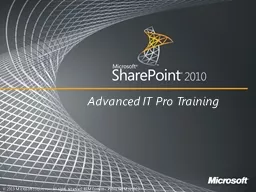

Name Title Company Agenda 2007 Recap Client Integration Large List improvements Document Center Document Sets Scale Remote Blob Storage Knowledge Management MOSS 2007 Recap Repository services adjustable ID: 712732
Download Presentation The PPT/PDF document "Document Management Capabilities and Fea..." is the property of its rightful owner. Permission is granted to download and print the materials on this web site for personal, non-commercial use only, and to display it on your personal computer provided you do not modify the materials and that you retain all copyright notices contained in the materials. By downloading content from our website, you accept the terms of this agreement.
Slide1Slide2
Document Management Capabilities and Features in SharePoint 2010
Name
Title
CompanySlide3
Agenda
2007 Recap
Client Integration
Large List improvements
Document Center
Document Sets
Scale
Remote Blob Storage
Knowledge ManagementSlide4
MOSS 2007 Recap
Repository services (adjustable)
Recycle Bin
Check-in/out
Major/minor versioning (with trimming)
Item-level permissionsContent TypesPolicy per Content TypeWorkflowDocument libraries offline in OutlookSlide5
Client Integration
Create: Discover Templates and Save Locations
Use a repository’s content types when creating new documents
Register common SharePoint sites with Office applicationsSlide6
Client Integration
Access SharePoint Context and Metadata
View policy statements
Manage versions
Edit SharePoint
metadataSlide7
Client Integration
Co-author SharePoint DocumentsSlide8
Client Integration
Offline Access and Differential SaveSlide9
Large List Improvements
Throttling
and
Limits
Compound
Indexes Managed Metadata Content Query Web part Slide10
Large Lists and Document Libraries in MOSS 2007
List Views
Folders
Column Indexes
Search
ViewsDocument CenterSlide11
Throttling and Limits
Function
Limit
Configurable
List View Threshold
5,000 (20,000 for admins & auditors)
Yes, Central Admin/web App Settings
List View Lookup
8
Yes, Central Admin/web App Settings
Allow OM Override
On by default
Yes, Central Admin/web App SettingsDaily time windowNoneYes, Central Admin/web App SettingsIndexes Per List20
NoDatasheet View and Export To Excel50,000NoUnique Permissions50,000Yes, Central Admin/web App SettingsSharePoint Workspace30,000
NoSlide12
Privileged Operations
List
Exceeds the List View
Threshold
Container
Exceeds the List View Threshold Slide13
List Exceeds the List View Threshold
Add/Remove/Update a list
column
Add/Remove/Update a List Content
Type
Create/Remove an IndexManage files which have no checked in versionNon-indexed recursive queriesCross list queryLookup columns that enforce relationship
behaviorDeleting a list/siteSave List as Template with Data
Showing Totals in List
Views
Enable/disable attachments in a listSlide14
Container Exceeds the List View Threshold
Delete/Copy/Rename a
folder
Non-indexed
queries
Set fine grained security permissionsOpen with ExplorerSlide15
Document Center:
Scenario Overview
Content
Reasonably large number of documents (500-500,000)
Active – still being Authored AND Consumed
Typical examplesRepeatable, semi-structuredContractsFunctional specificationsConsulting engagements
ManagementUsually has a “content steward” defining the library structure, metadata, templates, business process, etc.Slide16
Document ID’s
Document
ID service
(site
collection
level)Not on by defaultNot for List items, docs onlyKept during operationsNew ID on copy operationsAssigns “static url”Adds to Document & Document Sets Content TypeDocument ID Lookup Box Web Part Slide17
Document Center
DemoSlide18
New object to manage work products made up of multiple documents
Think Folder++
Key Scenarios
Tight collection of documents
A sales proposal that includes documents (proposal), spreadsheets (quotation), and presentations
Heterogeneous file types not usually assembledCompound documentsA user manual that is an assembled roll-up of separate sectionsDocument Set FeaturesShared MetadataCustomized welcome page
Default documents addedVersion captureWorkflows
Portability (download/upload/send to record center)
Document
Sets:
Scenario OverviewSlide19
Document Sets
DemoSlide20
Content Organizer
Document
routing engine
for document
management and records
managementUses Site Content TypesRules basedRules ListContent typePropertiesDrop-off libraryRequired PropertiesSlide21
SharePoint 2007
High scale libraries require careful planning and management
SharePoint 2010
End user features for high scale
Ex: Metadata pivots, Key filters, Content organizer
Server automatically “does the right thing” for high scaleCompound Index supportAutomatic index managementQuery throttling w/ fallbackSharePoint 2010 Scale Targets1 million items in a folder10’s of millions of items in a single library
100’s of millions of items in large archive scenarios
ScaleSlide22
Distributed Scale Out Architecture
To scale to 100s of millions of records, we’ll need to partition the archive across several databases and sites.
SharePoint 2010 includes features to ensure centralized management of this distributed data:
Enterprise Content Type and Policy service
Share content types across site collections
The content organizer distributes submissions across the sites.Centralized eDiscovery searches across all sites.
FAST Search ensures a unifiedretrieval experience.Slide23
Remote BLOB Storage
SharePoint 2010 and SQL 2008 R2 will support external storage of BLOBs (RBS)
Configured per content DB
Interesting scenarios leveraging the Content Organizer
Benefits of SP 2010 with RBS storage system:
Better CAPEX for large scale deployments (> 5 TB)Better OPEX for fault tolerance, backup/restore and geo-replicationSlide24
Balance Tensions with Wikis and
Doclibs
One Document Library
One Pages Library
A Document
Center
High-value, managed content
Not a walled garden
Submissions come from anywhere
A Publishing Site
Pages are storefronts
Consistent Wiki-like experience
Implicit structure
Shared Services
Enterprise consistency
Taxonomy and Folksonomy
Content
Types
Managed Metadata
Content Analytics
Social FeedbackSlide25
Example: Content Query Web Part on a Document Library
Balance Tensions with Wikis and
DoclibsSlide26
Summary
2007 Recap
Client Integration
Large List improvements
Document Center
Document SetsScaleRemote Blob StorageKnowledge ManagementSlide27Slide28
©
2009 Microsoft
Corporation. All rights reserved. Microsoft, Windows, Windows Vista and other product names are or may be registered trademarks and/or trademarks in the U.S. and/or other countries.
The information herein is for informational purposes only and represents the current view of Microsoft Corporation as of the date of this presentation. Because Microsoft must respond to changing market conditions, it should not be interpreted to be a commitment on the part of Microsoft, and Microsoft cannot guarantee the accuracy of any information provided after the date of this presentation.
MICROSOFT MAKES NO WARRANTIES, EXPRESS, IMPLIED OR STATUTORY, AS TO THE INFORMATION IN THIS PRESENTATION.